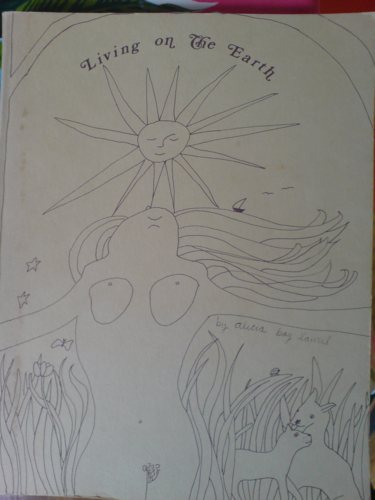
As soon as I saw the cover of Alicia Bay Laurel's Living on The Earth at the library sale, I knew I was buying it, and as soon as I opened it and found out the whole thing was handwritten--in cursive--I knew it would be one of my favorite 70's hippie how-to books ever. Little did I know that I was coming so late to the game; Living on The Earth was recognized as an irreplaceable back-to-the-land bible almost as soon as it was published in 1970, and it's still going strong. [Laurel's website shows the 1971 first Vintage edition, which makes my 1970 copy by Bookworks what, a pre-first edition?]
By the time you reach page 105 ["Hatha yoga keeps you stoned."], any illusions that Living on The Earth is for the lazy dropout-type hippie have been thoroughly dispelled. Though it may not appear to require much clothing, living on the Earth the LoTE way is a lot of hard work.
Laurel wrote down the basics of open land living while a resident at Wheeler's Ranch, one of two influential communes in Sonoma County.The book provides concrete advice for things like building a shelter ["If you live on land that has been raped ('logged'), you may find stumps that work as foundations for your house."]; setting up a commune ["how many dogs will you allow?"]; making and dyeing your own tunics, smocks, and saris; canning and pickling; and dressing game ["after you kill game, cut the jugular vein and hang it by the feet."]
I don't know how fantastical this all sounded in 1970, or how aware they were of completely tossing out some of the assumptions of modern life while leaving others intact. But some of the kid-related advice gives me the feeling of peering into a time machine at a long-lost--and much-changed--world. [More naked line drawings after the jump]
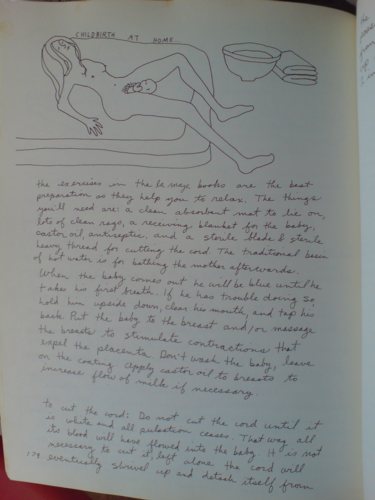
Childbirth at home: "don't wash the baby. leave on the coating. apply castor oil to breasts to increase flow of milk if necessary...a cup of sarsaparilla tea will quiet the muscles after the birth."
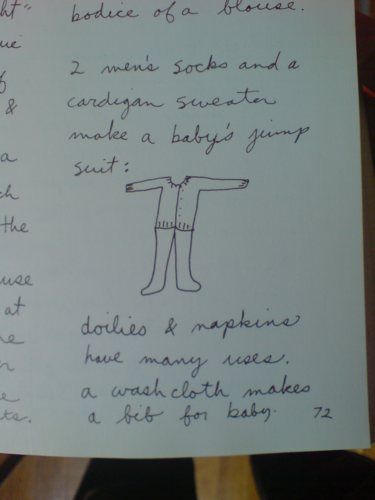
"2 men's socks and a cardigan make a baby's jumpsuit."
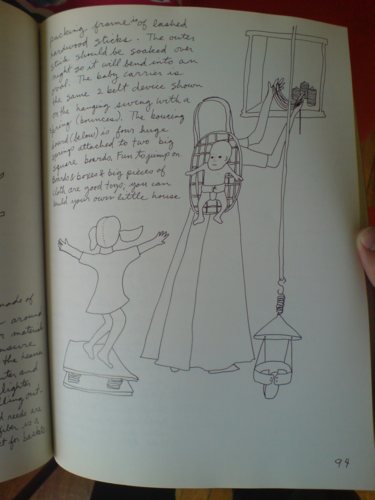
basketry: "The baby carrier is the same 2 belt device shown on the hanging swing with a spring (bounces)."

"doing laundry by hand: 1. Separate into piles: delicate things, white things, bright colored things, very soiled things, and heavy things (like blankets)." [hmm, so far it's all women. if I had to wash five loads of laundry by hand, I'd be a big nudism advocate, too.]
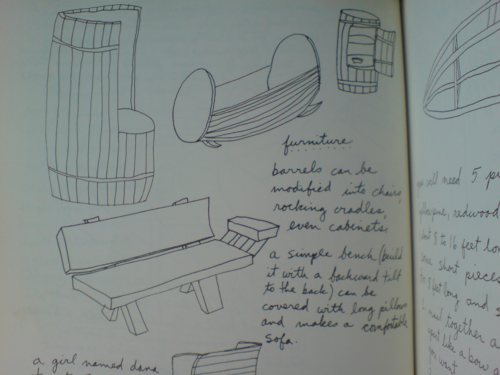
"furniture: barrels can be modified into chairs, rocking cradles, even cabinets." [Great, but where the hell are you gonna get a barrel? At the castor oil and sarsaparilla tea store?]

"Toys you can make:" "5. Stuff dolls & soft animals with either nylon foam rubber scraps (from sponge factories or sometimes sold as pillow stuffing.)" [note to self: set up next commune closer to sponge factory.]

"More toys you can make:" "animal toys: stick toothpicks into peanuts (in shells)" [you know what? just let the kids help with the hunting and fort building and canning and yoga; it sounds more fun.]
Here are some quotes from the introduction to Sam Binkley's groovy-sounding 2007 history, Getting Loose: Lifestyle Consumption of the 1970's:
Following the counterculture's halcyon days of the late 1960s, versions of this loosening metaphor would prove immensely popular and infinitely adaptable...Child-rearing practices embraced the "permissiveness" associated with the new child psychology espoused by Dr. Benjamin Spock, while loose, formless bean bag chairs flopped onto lush shag carpets and creative natural fabric wall hangings and macrame compositions adorned living room walls.Whether vintage or Living on the Earthnew and updated for our still-oppressive age, you need to buy a copy of Alicia Bay Laurel's Living on The Earth now. [amazon]...the diffusion of the loosening motif will be sought in volumes of lifestyle literature--what I term the countercultural lifestyle print culture of the 1970s. While originating in hippie networks and enclaves, these books and magazines rose to national celebrity, disseminating hippie lifestyle themes into the homes and habits of the American middle classes. In the early 1970s, as the youth movement turned its focus from mass mobilization and radical politics to more innocuous lifestyle issues, themes of self-loosening acquired a specifically prescriptive tone applied to a range of lifestyle practices...
The 1999 CD, Music From Living On the Earth, is also available as an MP3 download [amazon]
Buy Getting Loose: Lifestyle Consumption in the 1970s [amazon]
Related: Bell & Hollows' 2005 Historicizing Lifestyle: Mediating Taste, Consumption And Identity from the 1900s to 1970s sounds more complete and scholarly, but at $100 a throw, I won't be finding out [amazon]





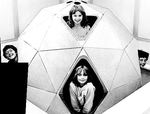
this is fantastic in that time capsule kind of way! i think my three year old would love to add some color to those illustrations!